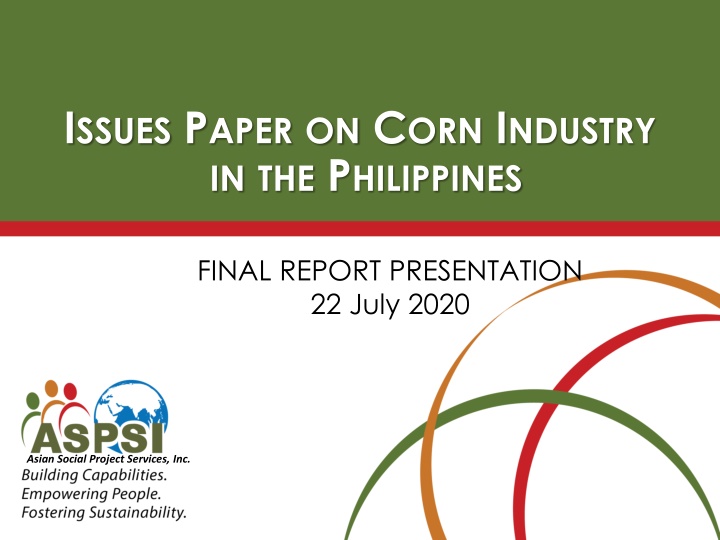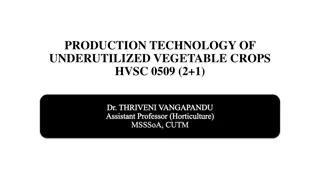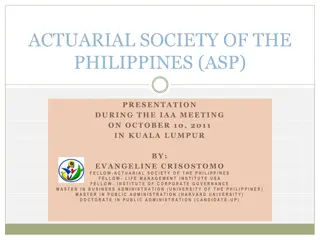ISSUES PAPER ON CORN INDUSTRY IN THE PHILIPPINES
This paper presents an in-depth analysis of the corn industry in the Philippines, focusing on white and yellow corn production, supply chain dynamics, competition issues, relevant policies, and recommendations for improvement. The study delves into supply and demand trends, stakeholder roles, regulatory frameworks, and data sources used in the research.
Download Presentation

Please find below an Image/Link to download the presentation.
The content on the website is provided AS IS for your information and personal use only. It may not be sold, licensed, or shared on other websites without obtaining consent from the author.If you encounter any issues during the download, it is possible that the publisher has removed the file from their server.
You are allowed to download the files provided on this website for personal or commercial use, subject to the condition that they are used lawfully. All files are the property of their respective owners.
The content on the website is provided AS IS for your information and personal use only. It may not be sold, licensed, or shared on other websites without obtaining consent from the author.
E N D
Presentation Transcript
ISSUES PAPER ON CORN INDUSTRY IN THE PHILIPPINES FINAL REPORT PRESENTATION 22 July 2020 Asian Social Project Services, Inc.
OUTLINE OF PRESENTATION I. Introduction II. Methodology III. Results and Discussion A. Description of the Philippine corn industry B. Supply chain and role of stakeholders C. Possible competition issues at each stage of supply chain D. Policies and regulations relevant to possible competition issues IV. Summary, Conclusions and Recommendations Issues Paper on Corn Industry in the Philippines
I. INTRODUCTION Two major types of corn produced in the Philippines White flint corn serves as a primary substitute to rice as food staple Yellow corn primarily as feed ingredient for hogs, poultry, and fish Corn industry in the Philippines could be better appreciated if we separate white from yellow Issues Paper on Corn Industry in the Philippines
I. INTRODUCTION Supply and Demand for Corn White corn relatively consistent over recent years; demand is met by local production Yellow corn rising production and demand driven by increasing demand for meat; additional yellow corn and other substitutes are imported to address supply deficit Issues Paper on Corn Industry in the Philippines
Objectives of corn issues paper study 1. Describe the Philippine corn industry, with focus on white corn and yellow corn as well as its substitutes Describe the role of stakeholders in each level of supply chain in key corn producing regions Identify possible competition issues at each stage of the supply chain i.e. from production inputs to marketing of output Describe policies and regulations relevant to possible competition issues Propose recommendations to address the identified possible competition issues 2. 3. 4. 5.
II. METHODOLOGY Types and Sources of Data Primary data collected through Key Informant Interviews (KIIs) and Focus Group Discussions (FGDs) Secondary data production, consumption and other quantitative from the Philippine Statistics Authority (PSA), United Nations Comtrade Database, and Global Trade Atlas Issues Paper on Corn Industry in the Philippines
II. METHODOLOGY Rationale for selecting Isabela, Bukidnon and Cebu as study sites Isabela & Bukidnon: top yellow corn producing regions and provinces based on most recent data from PSA Cebu: historical high white corn per capita consumption Accessibility and budget constraints Focused more on yellow corn than white corn Issues Paper on Corn Industry in the Philippines
KII and FGD stakeholders, locations, and time period Stakeholders / Respondents Corn industry association Chicken and hogs feed miller Broiler industry player Eggs industry player DA official (BPI) Seed company association Animal nutrition expert Corn farmers Corn traders Corn feed millers Provincial agriculturists DA region office staff Activities Locations Period Key informant interviews and Focus Group Discussions Manila Batangas Laguna Cebu Isabela Bukidnon August to October 2019 February 2020 Issues Paper on Corn Industry in the Philippines
II. METHODOLOGY Supply Chain Framework Farm Input Supply Consumption Retailing Processing Trading Production Product flow Payment and information flow Supply Chain Model Issues Paper on Corn Industry in the Philippines
III. RESULTS AND DISCUSSION Description of the Philippine Corn Industry First, differentiating between different types of corn based on color and nature of the grain Type of corn Flint Glutinous Sweet yellow milled (hammer type) for feeds; used also in cereals, chippy , in brewery (not common) boiled when at soft dough stage white milled into grits as food boiled when at soft dough stage; at matured stage processed to binatog , cornick or cornstarch not common other colors not common not common not common
White (flint) corn is consumed mostly in mountainous areas in Visayas and Mindanao Yellow corn is extensively used for feeds unlike other countries such as Mexico where yellow corn is the type used for food Market for yellow corn is mainly feed producer (domestic and foreign companies) Issues Paper on Corn Industry in the Philippines
Selected key feed producers in the country Major Domestic Players: B-MEG of San Miguel Foods Incorporated (SMFI) Univet Nutrition and Animal Healthcare Company (UNAHCO), Inc. Pilmico Foods Corporation (Pilmico) Universal Robina Corporation (URC) Major Foreign Players: Charoen Pokphand Foods (CPF) of Thailand New Hope Group of China Sun Jin of Korea Issues Paper on Corn Industry in the Philippines
STRUCTURE OF SUPPLY: Local Corn Production Region 10 (Northern Mindanao) 15% Region 12 (SOCCSKSARGEN) 11% Other Regions 46% Region 10 (Northern Mindanao) 21% Other Regions 39% Region 12 (SOCCSKSARGEN) 18% ARMM 22% Region 2 (Cagayan Valley) 28% Source: PSA, 2019 Source: PSA, 2019 yellow corn, 2018 white corn, 2018 White corn is mostly from Mindanao while yellow is from Luzon and Mindanao
Factors affecting production Weather patterns Nationally, bi-modal rainfall pattern: wet season usually starts in May/June and dry season starts in October/November 350.00 P Wet season H 300.00 250.00 Rainfall (m m ) H P Dry season 200.00 P Add dry season H 150.00 100.00 Qtr 1 Qtr 2 Qtr 3 Qtr 4 50.00 0.00 Source: PAGASA JAN FEB MAR APR MAY JUN JUL AUG SEP OCT NOV DEC 30-Year Monthly Rainfall Average in the Philippines
By Island Group 450 400 350 300 250 200 150 100 50 0 Jan Feb Mar Apr May Jun Jul Aug Sep Oct Nov Dec By Island Group Luzon Visayas Mindanao 450 400 350 300 Rainfall distribution 250 (mm) 200 150 100 50 0 Month Jan Feb Mar Apr May Jun Jul Aug Sep Oct Nov Dec Month Luzon Visayas Mindanao Comparative Rainfall Pattern by Island Group Mindanao (gray) has broader cropping window compared to Luzon (blue). Visayas (orange) is intermediate. Hence Mindanao is touted as breadbasket of the country.
Production (blue) vs Rain (green) per Quarter (%/year) Planting in May/June harvested in Aug/September (Q3) Planting in October/November harvested in Jan/Feb (Q1) Planting in Jan harvested in April 40.00% 35.00% 30.00% 25.00% 20.00% 15.00% 10.00% 5.00% 0.00% 1 2 3 4 JFM AMJ JAS OND % Rain/yr 1980-2020 Prodn % 2000-2018
100 90 80 70 60 Share (%) 50 Wet 40 Dry 30 20 10 0 2014 2015 2016 Year 2017 2018 Source: PSA, 2019 Percent share of production between the dry and wet seasons, Philippines 2014-2018 Issues Paper on Corn Industry in the Philippines
Genotype (Variety) Seeds Can either be open-pollinated variety (OPV) or hybrid Advances in genetics allow introducing genes for specific traits in the parent material through genetic engineering Development of genetically modified (GM) seeds has led to an increase in yellow corn productivity (19% yield increase, 10% cost reduction, 8% increase in farm income STRIVE 2012) Issues Paper on Corn Industry in the Philippines
1.6 7.0 1.4 6.0 Area Harvested (million ha) Production (million mt) 1.2 5.0 1.0 4.0 0.8 3.0 0.6 2.0 0.4 Area Harvested (left axis) Production (right axis) 1.0 0.2 0.0 0.0 1975 1976 1977 1978 1979 1980 1981 1982 1983 1984 1985 1986 1987 1988 1989 1990 1991 1992 1993 1994 1995 1996 1997 1998 1999 2000 2001 2002 2003 2004 2005 2006 2007 2008 2009 2010 2011 2012 2013 2014 2015 2016 2017 2018 2019 Source: PSA, 2020 Trends in yellow corn production and area harvested, 1975-2019
Environment Refers to conditions where the crop is grown Production potential of a variety is dependent on soil fertility management, which calls for more intensive fertilization practices and entails increased fertilizer expenditure Issues Paper on Corn Industry in the Philippines
Imports - reasons, sources, prospects and effect on local production Production Imports Feeds 9,000 8,000 Volume ('000 metric tons) 7,000 6,000 5,000 4,000 3,000 2,000 1,000 0 2013 2000 2001 2002 2003 2004 2005 2006 2007 2008 2009 2010 2011 2012 2014 2015 2016 2017 Year Source: PSA 2019 Trends in domestic corn production, domestic corn used for feeds, and imported corn used for feeds, 2000-2017
Imports - reasons, sources, prospects and effect on local production Understanding Feed Wheat Wheat is the most widely grown food crop in the world and it is a temperate crop i.e. not adapted in tropical environments Two types of wheat: winter wheat and spring wheat - harvested during our 2nd and 4th quarter; with proper storage, feed wheat can therefore be available throughout the year Grains are milled into flour and used to make bread and other food products
Imports - reasons, sources, prospects and effect on local production Understanding Feed Wheat Wheat available for use in animal feed is typically a feed-grade wheat and is often the portion rejected for human food production .. A relatively poor-quality grain cannot be stored for long: when feed wheat comes in, it has to be used soonest.
Imports - reasons, sources, prospects and effect on local production Understanding Feed Wheat The Philippines imports feed wheat every month and therefore, when local corn harvest coincides with the arrival of feed wheat, the price of local corn is usually depressed This is a more pronounced during the 3rd quarter when the Philippines has the big bulk of local harvest and the quality of which is affected by lack of mechanical dryers.
Importation of corn and feed wheat 10,000 9,000 8,000 7,000 (thousand mt) 6,000 Volume 5,000 4,000 3,000 2,000 1,000 - 1992 2000 2008 1987 1988 1989 1990 1991 1993 1994 1995 1996 1997 1998 1999 2001 2002 Year 2003 2004 2005 2006 2007 2009 2010 2011 2012 2013 2014 2015 2016 2017 2018 Yellow corn production 1 Yellow corn imports 2 Estimated feed wheat imports 3 Source: PSA and USDA data Domestic production, corn imports, and feed wheat imports from 1987-2018 (cumulative figures, in 000 metric tons)
Importation of corn and feed wheat Others, 0.4% Myanmar, 1.8% India, 8.9% Indonesia, 25.0% Vietnam, 8.9% Argentina, 11.0% Thailand, 23.0% United States of America, 21.0% Source: UN Comtrade Data, 2019 Philippine corn imports by country of origin, in percent shares, 2018
Importation of corn and feed wheat 2500000 2000000 Canada Brazil India 1500000 in metric tons United States Russia Rest of the world 1000000 Black Sea EU Bulgaria 500000 Australia 0 2014 2015 2016 2017 2018 Source: UN Comtrade data, 2018 and PAFMI Feed wheat imports of the Philippines by country of origin, 2014-2018
Private sector imports yellow corn formerly through the National Food Authority (NFA) Imports are sourced mainly from United States, Argentina, and ASEAN member countries Wheat imports rose dramatically from 5.7 million tons in 2017 to 7.1 million tons (24 percent) in 2018 and the increase is attributable to increase in feed wheat demand in the country Wheat is imported all throughout the year Issues Paper on Corn Industry in the Philippines
Philippine feed wheat imports by quarter Year 2014 2015 2016 2017 2018 Source: UN Comtrade Data and PAFMI, various years, 2018 data is untill 3rd quarter only Quarter 1 87,000 520,223 316,703 640,821 638,295 Quarter 2 141,340 461,914 797,966 827,415 781,130 Quarter 3 425,179 415,563 489,092 560,994 811,730 Quarter 4 496,292 481,948 604,429 442,125 - Total 1,149,811 1,879,648 2,208,190 2,471,355 2,231,155 600,000 2nd Qtr after rice and 'palusot' crop in Mindanao 3rd Qtr: Luzon and Mindanao 4th Qtr: Mindanao 1st Qtr: Luzon and Mindanao 500,000 400,000 Volume (metric tons) 300,000 200,000 100,000 0 Month 2016 2014 2015 2017 2018 Wheat imports of the Philippines by month, and its timing with local corn harvest
Trends in yellow corn and wheat prices, 1990-2018 Source of basic data: World Bank Commodity Pink Sheet, 2019; Rice and Corn Situation and Outlook Bulletin, various years, 2019; and Tariff Commission of the Philippines, 2019 Source of basic data: World Bank Commodity Pink Sheet, 2019; Rice and Corn Situation and Outlook Bulletin, various years, 2019; and Tariff Commission of the Philippines, 2019 with tariff without tariff Comparative price (yearly average) of domestic corn (blue), imported corn (orange) and feed wheat (gray). Lately, with tariff, feed wheat has become cheaper than domestic and imported corn with tariff. Without tariff, imported corn is cheaper than feed wheat and domestic corn. After covid, what happens to international trade?
Local farm gate prices of corn go down even if international market prices might be high; this is primarily due to the lack of storage capacity when import delivery (corn and/or feed wheat) coincides with local harvest (KIIs) Lower price (and income) dampens the interest and capacity of farmers to plant the next season hence feed millers have to buy high the next time around because of reduced local supply This explains the boom and bust cycle in the Philippine yellow corn industry; but with more feed wheat imports, yellow corn farm gate prices might continue to be in a bust. Issues Paper on Corn Industry in the Philippines
Supply chain and role of stakeholders (1) White Corn Supply Chain in Cebu
White Corn Supply Chain in Cebu Production inputs are readily available within the municipality White corn production in Cebu is classified as subsistence farming Supply chain is relatively short Mills serve as service providers White corn grits in Metro Cebu is sourced from Mindanao Issues Paper on Corn Industry in the Philippines
(2) Yellow Corn Supply Chain in Isabela Breakdown of the consumer's peso from yellow corn grain to feed, Isabela Buying price (PHP/kg feed basis) 0.00 7.30 8.05 Selling price (PHP/kg feed basis) 7.30 8.05 22.00 Marketing margin (PHP/kg feed basis) 7.30 0.75 13.95 Breakdown of consumer s peso 0.33 0.03 0.63 Chain player Farmer Trader-Processor Feedmiller-Retailer
Yellow Corn Supply Chain in Isabela Major production costs are material inputs Majority of the seed market is dominated multinationals: Syngenta, Pioneer, and Monsanto Farmers will either self-finance their farm operations or will avail of credit from trader- financiers Farmers located in far flung areas must rely on traders to transport their produce to local markets Issues Paper on Corn Industry in the Philippines
(3) Yellow Corn Supply Chain in Bukidnon Breakdown of the consumer's peso from yellow corn grain to feed, Bukidnon Selling Price (PHP/kg feed basis) 6.00 6.25 6.35 24.00 Buying Price (PHP/kg feed basis) Marketing Margina (PHP/kg feed basis) Breakdown of Consumer's Peso Chain Player Farmer Trader Cooperative-Processor Feed miller-Retailer 0.00 6.00 6.25 6.35 6.00 0.25 0.10 17.65 0.25 0.01 0.004 0.74
Yellow Corn Supply Chain in Bukidnon Major production costs are material inputs. Popular seed brands in the surveyed area are Pioneer, Bioseed, Evogene, and Maharlika Farmers will either self-finance their farm operations or will avail of credit from trader-financiers Farmlands in the areas can be rented to multinational companies not planting corn Cooperative-processors facilitates the flow of yellow corn through the supply chain Issues Paper on Corn Industry in the Philippines
(4) Pricing and costing at each level of supply chain a. Pricing and Costing of Seed Production Cost of developing Bt corn in the Philippines by major activity grouping, 2004 Area/Activity Cost (PHP) 5,199,741 1,988,113 7,009,088 44,379,128 Share (%) 4.1 1.5 5.5 34.7 Laboratory/greenhouse (US) Greenhouse (Philippines) Confined field trial (1999-2000 trials) Multi-location field trial (2000-2002 activities) Commercial propagation (2002 studies/activities, public info sheets and application fee) Post-commercial application (2003-2004 activities and 2003-2004 promotion material) Total 16,312,461 12.8 53,088,637 41.4 127,977,169 100 Issues Paper on Corn Industry in the Philippines Source: Manalo and Ramon, 2007
b. Pricing and Costing of Yellow Corn Grain Production Cost and Return of GM and Conventional Corn Production, Isabela, 2018 Yellow Corn Conventional Hybrid Corn (PHP) GM Hybrid Corn (PHP) Item A. LABOR (land prep, crop establishment, care and maintenance and post harvest activities) B. MATERIALS Seeds Herbicide Fertilizer Insecticide Sacks Twines and Needle Miscellaneous (snacks, meals , etc) C. TOTAL COST OF PRODUCTION D. YIELD Yield per hectare Selling Price per kilogram Source: Cagayan Valley Research Center, 2019 20,228.00 34,098.00 10,900.00 1,100.00 12,750.00 1,000.00 3,288.00 60.00 5,000.00 54,326.00 23,160.00 25,560.00 5,000.00 350.00 12,750.00 1,000.00 2,700.00 60.00 3,000.00 48,720.00 7,000 19.00 6,000 19.00
c. Pricing and Costing of Yellow Corn Grain Trading Operating and investment requirements of yellow corn traders per 1,000 kilograms of yellow corn sold, Isabela, 2019 Per 1,000 kg of yellow corn sold Values (PHP) Items % Share* OPERATING COSTS Yellow corn bought Hired labor and transportation TOTAL OPERATING COSTS INVESTMENT COSTS Trucks Floor weighing scale TOTAL INVESTMENT COSTS Source: Elca et al , 2020 13,060.71 10,000.00 23,060.71 56.64 43.36 100.00 2,500,000.00 75,000.00 2,575,000.00 97.09 2.91 100.00 Issues Paper on Corn Industry in the Philippines
d. Pricing and Costing of Feed Milling Operating and investment requirements of feed millers per 1,000 kilograms of feeds produced, Cagayan and Pampanga, 2019 Per 1,000 kg of feeds produced Small-scale in Cagayan Large-scale in Pampanga Items Values (PHP) % Share* Values (PHP) % Share* OPERATING COSTS Yellow corn bought Wheat Pollard Soya Copra Corn bran Rice bran Medicine Darak and molasses Business permits Electricity and water bills Sacks Other costs TOTAL OPERATING COSTS INVESTMENT COSTS Warehouse Pelletizer Crumbler Boiler/feed miller Trucks Truck scale Silo TOTAL INVESTMENT COSTS 8,051.20 33.32 5,250.00 1,580.00 1,520.00 2,380.00 1,250.00 1,550.00 1,500.00 1,500.00 1.02 0.31 0.29 0.46 0.24 0.30 0.29 0.29 - - - - 7,020.00 29.05 - - - - - - 15.00 0.06 9.67 2,336.00 - - - - 500,000.00 96.80 5,500.00 240.00 1,000.00 24,162.20 22.76 0.99 4.14 100.00 - - - - 516,530.00 100.00 500,000.00 38.46 50,000,000.00 5,000,000.00 5,000,000.00 3,000,000.00 14,850,000.00 2,000,000.00 2,000,000.00 81,850,000.00 61.09 6.11 6.11 3.67 18.14 2.44 2.44 100.00 - - - - 800,000.00 61.54 - - - - - - 1,300,000.00 100.00 Source: Elca et al, 2020
C. Possible competition issues Inputs Breakdown of the farmer costs for yellow corn grain, GM hybrid, Isabela Cost Percent share to total cost 20 23 37 20 100 Input (PHP/hectare) 10,900 12,750 20,228 10,448 54,326 Seeds Fertilizer Labor Other Inputs Total Cost a Includes herbicide, insecticide, sacks, and food cost Source: Cagayan Valley Research Center, 2019 Seeds, fertilizer and labor accounts for 80% of the total production cost of GM hybrid corn farming.
C. Possible competition issues Seeds - Multinational seed companies (Pioneer Dupont, Monsanto-Beyer, and Syngenta-China Chem) distribute their products through trader-financiers and/or agricultural supply dealers. - The average expenditure on seeds has increased from PHP 3,000/ha in 2009 to over PHP 10,000/ha in 2018 (PSA) - Local seed producers need licenses from multinational companies to produce accredited GM seeds. - Restrictive pricing of accredited GM seeds leads to the proliferation and use of sige-sige or ukay-ukay seeds (KIIs, 2019) Issues Paper on Corn Industry in the Philippines
Possible competition issues Seed Company Distributor Retailer Farmer Distribution of seeds from seed producer to farmers Source: PSA, 2019 Average seed costs paid in cash by yellow corn farmers from Region 1 and 2
Possible competition issues Fertilizer - No evidence for localized monopolies (PIDS studies: Briones, 2016 and Galang, 2017) - Regional price differences can be attributed to logistics-related costs Corn Output - Feed millers are able to import corn and other substitutes at anytime within the year in search of lower cost. - Producers are forced to settle for the best price available to them. Issues Paper on Corn Industry in the Philippines
D. Policies and Regulations relevant to possible competition issues RA 7308 or Seed Industry Development Act - New varieties have to undergo series of tests and pass the standards before they get accredited - Farmers need not patronize those accredited varieties, but they are left to their own resources and risks Issues Paper on Corn Industry in the Philippines
Policies and Regulations relevant to possible competition issues RA 9168 or Plant Variety Protection Act (PVPA) and Joint Department Circular No. 1 (2016) or JDC No. 1 (2016) - PVP certificate holders have the right to authorize the following: a. Production or reproduction b. Conditioning for the purpose of propagation c. Offering for sale d. Selling or other marketing e. Exporting f. Importing g. Stocking for any purpose mentioned above - In JDC No. 1 (2016), the owner of the technology owner could always renew their application to commercialize their technology every five years Issues Paper on Corn Industry in the Philippines
Policies and Regulations relevant to possible competition issues Markets for Local Corn The minimum access volume (MAV) as a means to ensure international trade and support local corn industry Importers can avail a lower import duty of 5 percent if the produce comes from any ASEAN- member country. Report of trans shipment from high tariff country to low tariff country. Yellow corn and feed wheat import trade is liberalized, anyone can now import Importation is essentially open, but export is not Tariff collected from importations supposedly meant to directly address the capability needs of local corn farmers like post-harvest and various field production needs. Issues Paper on Corn Industry in the Philippines
IV. SUMMARY, CONCLUSION AND SUMMARY, CONCLUSION AND RECOMMENDATIONS RECOMMENDATIONS Summary and Conclusions Corn grows all over the country, but some regions excel more than others. We have the potential to produce more Supply and demand for yellow corn is growing, and local yield levels are comparable to neighboring Asian countries Yellow corn and feed wheat are imported to address the gap in local supply Issues Paper on Corn Industry in the Philippines
Summary and Conclusions Productivity of white corn has remained low and flat due to limited demand Reducing seed costs can help lower the production cost for corn Open access to expired patented GMO genes could help in developing cheaper but still good quality seeds from the local hybrid corn seed developers Issues Paper on Corn Industry in the Philippines























